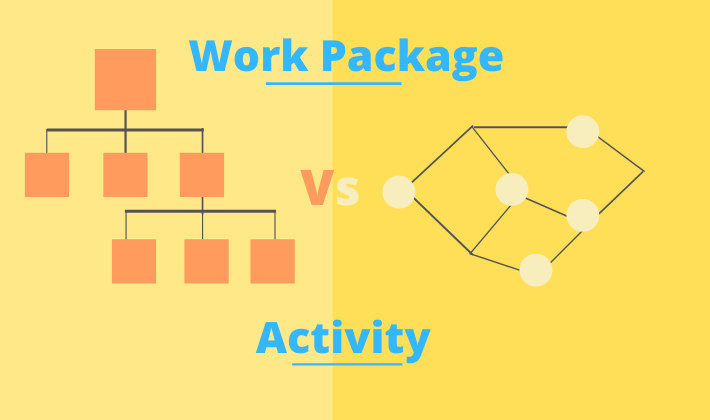A work package contains the work defined at the lowest level of the Work Breakdown Structure (WBS) for which cost and duration can be estimated and managed.
A WBS work package can be further decomposed (broken-down) into an activity list. The project team can produce a tangible outcome or create a deliverable by accomplishing these activities.
The main difference between work package and activity is that work package represents a tangible work product whereas a series of activities are required to be done in order to accomplish the result represented by the work package.
You might be looking for the difference between Work Package and Activity. It is very difficult to contrast work package vs activity by just looking at their definitions.
In this article, you will find definition, meaning, and explanation of work package and activities. You will find how these terms are used in project scope management and schedule management respectively. You will also find a few examples of these terms that will help you in understanding the difference between them.
Practically speaking, it doesn’t matter whether you call a work package an activity or vice-versa. At the end of the day, you have to complete your total project scope. The project work will not change because of changes in nomenclature.
However, if you are preparing for the PMP Exam then it is important to distinguish between a work package and activity.
You can also look at the following video to understand the difference between these project management terms.
Work Package in Project Management
The work defined at the lowest level of the work breakdown structure for which cost and duration can be estimated and managed.
PMBOK® Guide
You can refer to Max Wideman Glossary to read some other standard definitions.
A WBS is a deliverable oriented structure. A deliverable is a tangible outcome that gives satisfaction to one or more project stakeholders.
Work packages are smallest deliverable in a project. They reside at the lowest level of a WBS.
Activity Definition
A distinct, scheduled portion of work performed during the course of a project.
PMBOK® Guide
You can refer to Max Wideman Glossary to read some other standard definitions.
A work package is further decomposed into a sequence of activities. An activity in itself does not produce a deliverable but a sequence of activities culminates into a deliverable.
The above definitions are somewhat confusing. Even though the definitions absolutely correct, it is kind of impossible to differentiate between work package and activity just by looking at these definitions.
Difference Between Work Package and Activity
In simple terms we can say that
Work Package is a result of an endeavor.
We can also say that
a series of actions results in (creates) a Work Package.
Let us explore thw above statements further. A Work Package
- is smallest level of deliverable.
- is lowest component of a WBS.
- cannot be broken down further. It cannot be decomposed into a smaller level deliverable.
- provides some tangible value to the project stakeholder(s).
- is recognized, required and valued by the project Stakeholder(s).
- gives a sense of fulfillment & achievement to the project team.
- provides satisfaction to the the project Stakeholder(s). It is handed over to the project Stakeholder(s), once it is created.
Refer to the previous para. I wrote “a series of actions results in a (creates) a Work Package”. These actions are, in fact, the Activities performed by the project team.
In simple terms we can say that series of activities creates a Work Package. An Activity, in itself, may not produce any tangible outcome but a series of Activities would result into a deliverable.
The difference between work package vs activity is summarized in the table below.
| Work Package | Activity |
|---|---|
| It represents the smallest deliverables of a project. | It is a means to create a deliverable. Accomplishing series of activities results in a deliverable. |
| It is the result or outcome of an endeavor. | It is one step of an endeavor. |
| A deliverable has a tangible value and it is generally handed over to the project stakeholders. | It cannot be handed over to the project stakeholders. |
| It fulfills a portion of project and provides partial satisfaction and some value to the project stakeholders. | Completion of a single activity does not provide any value to the project stakeholders. |
| It is generally defined using a noun (outcome) e.g. ‘Module X’. | It is generally defined using a verb (work to be done) e.g. ‘testing’. |
Examples of WBS Work Package and Activities
Let us take a look at two examples to understand the difference further.
Software Development Project
Let us assume that project team has created a WBS with software modules as work packages. Integration of all modules will result in the completion of the software product. One such module could be “Module X”.
Module X can be thought of as a work package. Project Team will have to perform series of Activities to create “Module X”. These Activities might include Algorithm Writing, DB Scripting, Coding, Testing, Integration etc. Project Team might have to repeat these activities until delivery ready “Module X” is created.
Building Construction Project
Let us assume that project team has created a WBS with building floors as work packages. Completion of all floors will result in the completion of the Building. One such floor could be “Floor N”
Floor N can be thought of as a work package. Project Team will have to perform series of Activities to construct “Floor N”. These Activities might include Floor laying, Wiring, Painting, Inspection etc. Project Team might have to repeat these activities until delivery ready “Floor N” is completed.
Frequently Asked Questions
Over To You
How do you use the terms work package and activity in your organization? Do you use them interchangeably? Do you think it is important to distinguish between these terms.
I would love to hear from you.









Great work in differentiating the WBS and Activity, Sometimes in my past i have referred a WBS as an activity during my representations. Hereafter will have a different note on both. Thanks MR PM
Thanks Ashok.
Hi,
I am a PMP aspirant. I understand that the WP is the work defined at the lowest level of the WBS for which duration and cost can be estimated. Does it mean aggregate value of duration or costs of all the activities to complete this WP? I mean the bottom-up approach and it produces only the cost of WP, not the project cost.
Mahabubur,
Three things:
1. Aggregate cost of all WP activities + Contingency reserves = Cost of WP
2. “Aggregate duration of all WP activities” may or may not be equal to “Duration of WP”. The “Duration of WP” will depend on how WP activities are scheduled.
3. Aggregate cost of all WP + Contingency reserves = Project Cost.
Hope it helps.
Hi Praveen,
When the WBS is developed, what is the approach to estimate its work packages? Per PMBOK (when using buttom-up methods) we need first to create a list of avtivities for each work packagess and estimate each of those activities. Such edtimates then roll up to the work package level. But some literature on the subject doesn’t mention esimating of activities first in order to estimate a work package. Instead it suggest to edtimste effort and duration right on work package level.
Please explain that.
Thank you,
Alex
Hi Alex,
PMBOK Guide does not prescribe any particular method. You should read the definition of Work Package in Glossary section of the PMBOK Guide. It clearly says that estimation can be done at WP level.
Estimation can be done at the Project or planning package level also. It depends on the how much detailed information you have about the component you are estimating and how much deep are you willing to go.
Hope it helps.
Thanks alot 🙂
What is allowed difference between WBS and Estimation, can it be negative value or only positive valus?
There is no comparison between WBS and estimation. WBS is a diagram while estimation is done to forecast the quantitative value of time, cost or resources.
BR, Praveen.
What is the shortest and longest time for WBS and an activity?
Hameed, I would suggest you to read the article again especially FAQs. There could be organizational guidelines for such limits. But generalization is impossible since every industry has different type of projects. You might find some limits in old PM literature but such limits are unnecessary.
BR, Praveen.
Very thanks for the article. It was very helpful.
Carlos Marcelo
Recife, Brazil
Thanks Carlos.
Thanks to your post, I’m able to understand what WBS means. Thank you professor.
From South Korea
Hi Jaeseong, You can look at this video to understand WBS – https://www.youtube.com/watch?v=RCBDkSgDssk